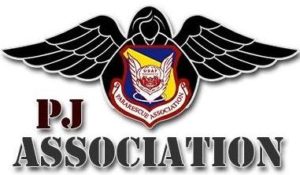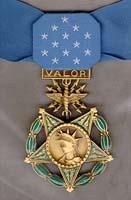For conspicuous gallantry and intrepidity at
the risk of his life above and beyond the call of duty during a Combat
Search and Rescue Mission during the Vietnam War.
|

|
Citation to accompany the award of
the Medal of Honor to Airman First Class William H. Pitsenbarger
|
| |
|
Airman First Class Pitsenbarger distinguished himself by extreme
valor on 11 April 1966 near Cam My, Republic of Vietnam, while
assigned as a Pararescue Crew Member, Detachment 6, 38th
Aerospace Rescue and Recovery Squadron. On that date,
Airman Pitsenbarger was aboard a rescue helicopter responding to
a call for evacuation of casualties incurred in an on-going
firefight between elements of the United States Army's
1st Infantry
Division and a sizable enemy force approximately 35
miles east of Saigon. With complete disregard for
personal safety, Airman Pitsenbarger volunteered to ride
a hoist more than one hundred feet through the jungle,
to the ground. On the ground, he organized and
coordinated rescue efforts, cared for the wounded,
prepared casualties for evacuation, and insured that the
recovery operation continued in a smooth and orderly
fashion. Through his personal efforts, the evacuation
of the wounded was greatly expedited. As each of the
nine casualties evacuated that day were recovered,
Pitsenbarger refused evacuation in order to get one more
wounded soldier to safety. After several pick-ups, one
of the two rescue helicopters involved in the evacuation
was struck by heavy enemy ground fire and was forced to
leave the scene for an emergency landing. Airman
Pitsenbarger stayed behind, on the ground, to perform
medical duties. Shortly thereafter, the area came under
sniper and mortar fire. During a subsequent attempt to
evacuate the site, American forces came under heavy
assault by a large Viet Cong force. When the enemy
launched the assault, the evacuation was called off and
Airman Pitsenbarger took up arms with the besieged
infantrymen. He courageously resisted the enemy,
braving intense gunfire to gather and distribute vital
ammunition to American defenders. As the battle raged
on, he repeatedly exposed himself to enemy fire to care
for the wounded, pull them out of the line of fire, and
return fire whenever he could, during which time, he was
wounded three times. Despite his wounds, he valiantly
fought on, simultaneously treating as many wounded as
possible. In the vicious fighting which followed, the
American forces suffered 80 percent casualties as their
perimeter was breached, and airman Pitsenbarger was
finally fatally wounded. Airman Pitsenbarger exposed
himself to almost certain death by staying on the
ground, and perished while saving the lives of wounded
infantrymen. His bravery and determination exemplify
the highest professional standards and traditions of
military service and reflect great credit upon himself,
his unit, and the United States Air Force. |
|
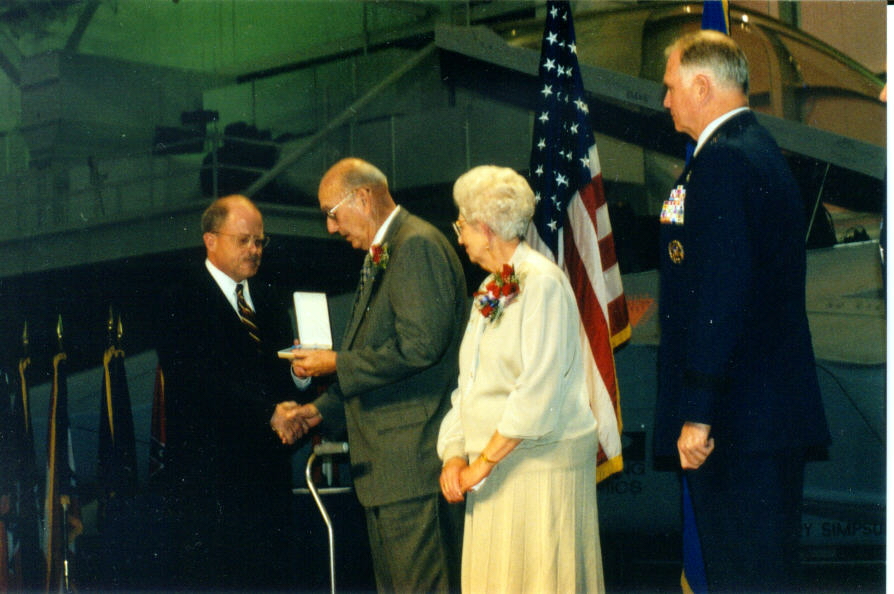
Secretary of the Air Force Whitten Peters presents Medal of
Honor to Bill Pitsenbargers parents
|
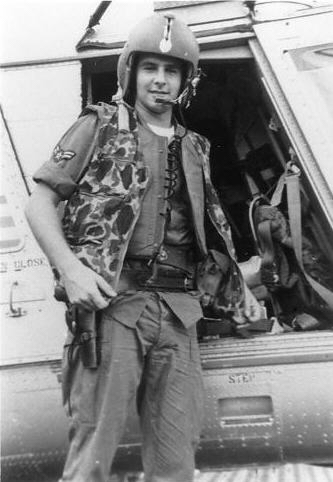
USAF Photo |

USAF Photo |
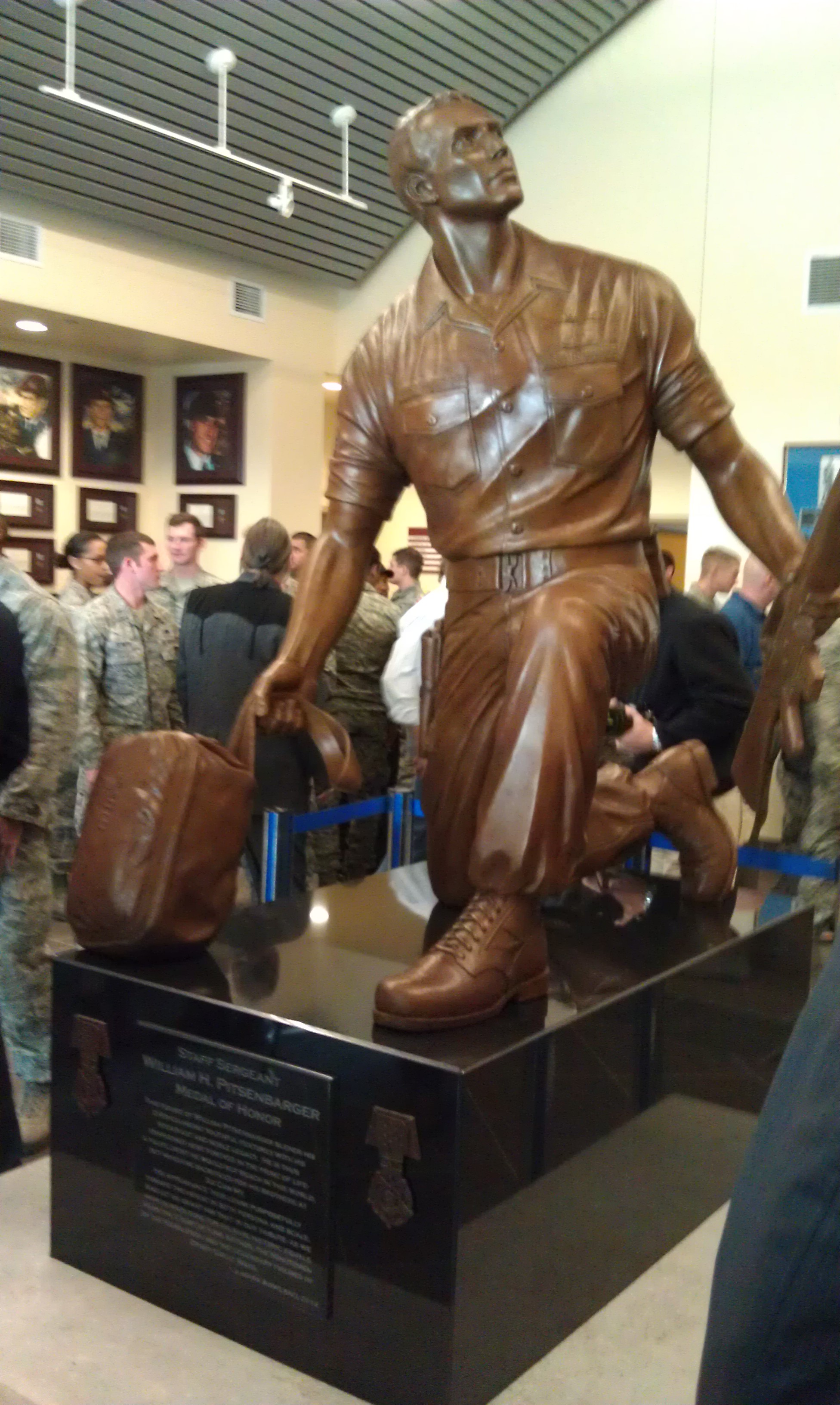
Memorial at USAF Pararescue School |

1966 Vietnam HH-43 crews
Pitsenbarger is front row left side |
|
STORY
ABOUT THE SAR BILL PITSENBARGR WAS AWARDED THE MEDAL OF HONOR
Excerpted from the book "PJs in Vietnam by Robert LaPointe"
|
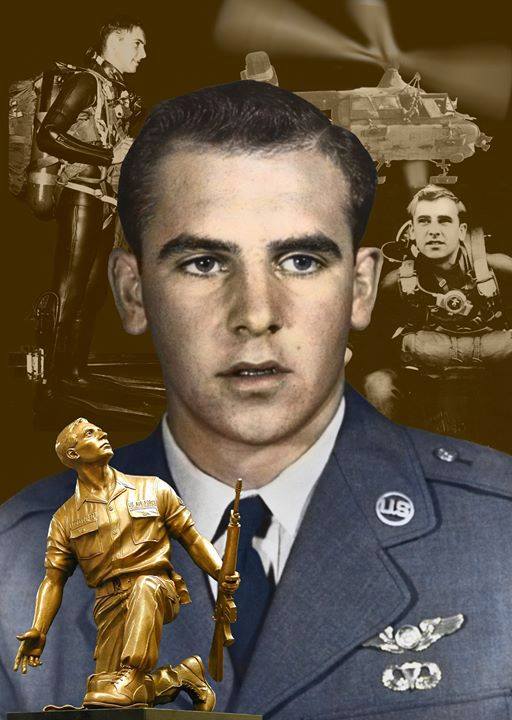 |
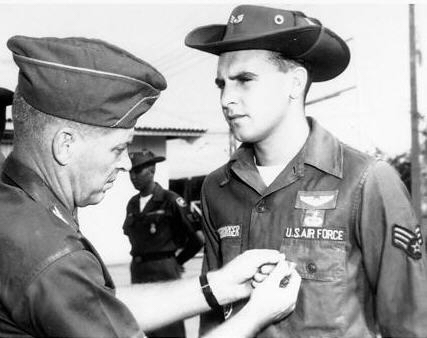
 |
|
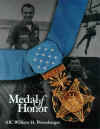
HANDOUT FROM MOH CEREMONY
SECRETARY AIR
FORCE AWARD SPEECH |
DOCUMENTS USED FOR MOH SUBMISSION
NEWS ARTICLE RE:
AFC & MUD SOLDIERS
AIRMAN MUSEUM
MONOGRAPH AFC |
1966 Airman Magazine Article
ONE DAY AT A TIME |
2000 Airman Magazine Article
THEY CALLED HIM PITS |
U.S. Air Force
Video on YouTube:
Portraits in Courage - William Pitsenbarger |
A movie about Bill Pitsenbarger's mission was released in 2020. The
title is "The Last Full Measure" and it is an accurate portrayal of
Bill's last mission and the long delay in finally being awarded the
Medal of Honor. There are two issues in the movie that require
explanation. First, the helicopter used in the movie was a UH-1 Huey;
but, the HH-43 Huskie was the actual type flown on that mission. The
reason for this swap of helicopter types was that there were no HH-43's
that were flyable for use in the movie. The last flight by the USAF of
this helicopter was in 1975. At the time of the movie, there was only
one known HH-43 that was still flying and it was in the USA. The jungle
scenes of the movie was filmed in Thailand. The second issue is the
uniform worn by Pitsenbarger in the movie was the USAF fatigue uniform
with blue and white patches and rank insignia. This was the same uniform
worn by airmen the world over in the 1960's. Airman Pitsenbarger
actually wore the same type jungle fatigues worn by the Army soldiers in
the movie. The more visible uniform worn by Pits was an intentional
deviation from the facts in order that Pits would stand out from the
grunts. Had he worn the same uniform as the Army troops it would have
been very difficult to ascertain who was who in the movie.
Movie Synopsis
The Last Full Measure centers on the true story of Vietnam War
hero William H. Pitsenbarger, a U.S. Air Force Pararescueman who
personally saved over 60 men during the Vietnam War. During a rescue
mission on April 11, 1966, Pits, as he was called, chose to leave the
relative safety of his rescue helicopter to aid wounded soldiers under
heavy fire. After saving many, he was ordered to leave on the last
helicopter out of what became one of the war's bloodiest battles. He
chose to stay, sacrificing his own life to save and defend soldiers of
the U.S. Army's 1st Infantry Division.
32 years later, Pentagon staffer Scott Huffman, is reluctantly tasked
with investigating a posthumous Medal of Honor request for Pitsenbarger
by his parents and Tom Tulley, Pitsenbarger's partner on the fateful
mission. Huffman seeks out the testimony of Army veterans who witnessed
or were saved by Pitsenbarger's extraordinary valor. As Huffman learns
more about Pitsenbarger's selfless courage, he uncovers a decades-long,
high-level conspiracy: as of Pitsenbarger's death in combat in 1966. The
Air Force had never put forth the names of enlisted personnel to receive
the Medal of Honor. This prompts him to put his own career on the line,
potentially creating controversy around the company's former commanding
officer who ordered the highly dangerous mission, and who is now a US
senator seeking reelection.
When a Senate effort to award the medal fails on the floor of
Congress due to unrelated political infighting, Huffman goes public with
the story, and ultimately the Medal of Honor is awarded to Pitsenbarger
by presidential decree. Pitsenbarger's father, who is dying of cancer,
and mother are in attendance as their son's duty, courage and sacrifice
is recounted. The Air Force Secretary presents the medal to the parents,
then recognizes everyone in attendance, all of whose lives were
influenced by Pitsenbarger's actions, saying, "This is the power of what
one person can do." The epilogue points out that as of 2019, of the
3,489 Medal of Honor recipients among millions of US military personnel,
only three airmen have been enlisted Air Force.
 |
|
|
Return to Medals Homepage
Return to PJ History
Homepage |
|
Email to
historian@pjhistory.org |
© All rights reserved. Reproduction in whole or in part,
in any form or medium, without the expressed written permission of the
Pararescue Association is Prohibited |
|
|

